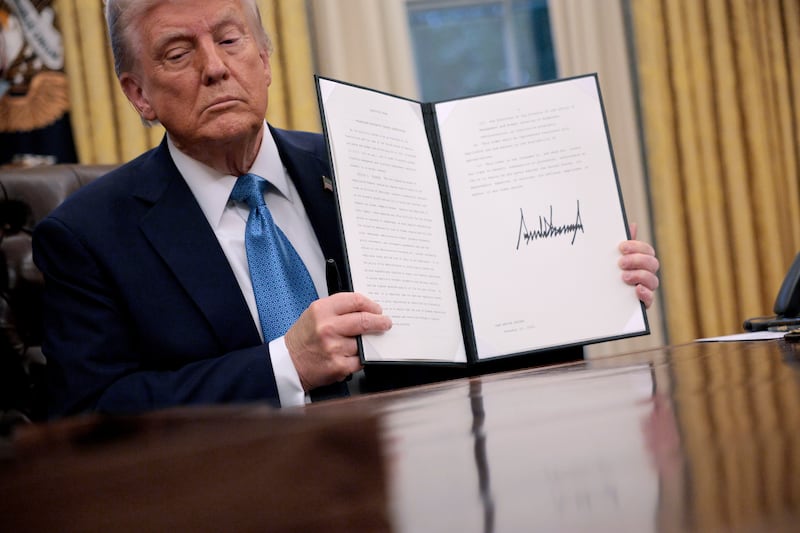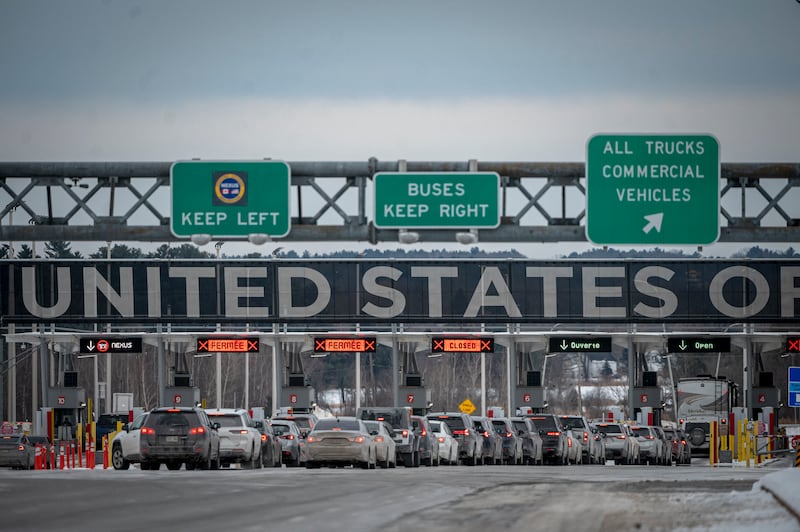Is US president Donald Trump opening the door to a wider global trade war – one that could have dire consequences for the global trading system – or merely using the threat of tariffs to extract quick concessions from competitor countries?
Trump regularly changes his rationale for tariffs. Sometimes he talks about using them to correct trade imbalances. He has described the US’s trading relationship with Europe as an “atrocity” and has long railed against the one-sided nature of German car exports. “How many Chevrolets or Fords do you see in the middle of Munich?” he said this week.
Sometimes he talks about revenue-raising potential of tariffs, claiming this could be used to replace the income tax as the primary source of revenue for the US. He has promised to create a new “external revenue service” to collect and redeploy these payments.
Sometimes he simply uses the threat of tariffs to coerce diplomatic change. Earlier this month he threatened Colombia with tariffs for refusing to accept military flights carrying deportees.
READ MORE
Keeping the world guessing seems to be part of Trump’s modus operandi (MO).
US policy uncertainty is now a major global risk. Drinks maker Diageo this week scrapped its sales growth guidance for the year because of the uncertainty posed by US tariffs.
That said, markets seem to have concluded that on trade at least, the US president is more bluster than action. This week he retreated from threats to impose 25 per cent tariffs on Mexico and Canada on the back of rather flimsy commitments by both countries to beef up border security. More likely it was because of the negative market reaction and blanket criticism from business.
JP Morgan, Wall Street’s biggest bank, labelled the president’s tariff plan “business unfriendly”. An editorial in the traditionally supportive Wall Street Journal called it “the dumbest trade war in history”.
“Donald Trump came in issuing threats, which is his MO, and he got punched in the nose,” Scott Lucas, Professor of International Politics at the Clinton Institute in University College Dublin told The Irish Times Inside Business podcast.

Are we at the beginning of Donald Trump’s global trade war?
Trump has always been sensitive to market feedback. During his first term in office he regularly tweeted about the market, taking credit if it was up.
If he backed away from Mexico and Canada, he did press ahead with 10 per cent tariffs on Chinese imports – a far cry from the 60 per cent promised during the election campaign – a move that has drawn retaliatory action.
While tit-for-tat trade sanctions can, as history shows, spiral, Beijing’s response seems designed to tamp things down, hitting less sensitive US products like coal and liquefied natural gas (LNG) as well as agricultural machinery.
Next on Trump’s tariff blacklist is the EU, a trading relationship he regularly fumes about. According to the European Commission, the US had a trade deficit (for goods) with the bloc of €155.8 billion in 2023. The US runs a trade surplus with the EU when it comes to services (primarily because of US’s predominance in the world of Big Tech), but not enough to offset the goods deficit.
This is where Ireland and its exposure to US policy uncertainty comes in. The US is the number-one country for Irish goods exports. It bought €54 billion-worth of products in 2023. In the first 11 months of 2024, this had risen to €67 billion.
This means more than a third of Irish goods exports end up in the US.
Of that €67 billion, more than €50 billion relates to pharmaceuticals and chemicals, the bulk of which are produced by US pharma companies, illustrating how Ireland has become a major offshore hub for the US pharma industry.

Pharma giant Eli Lilly, for example, is manufacturing its popular weight loss drugs in Ireland and shipping them back to the US.
What is likely to attract the attention of Trump’s economic advisers is not so much the volume of goods but the large trade surplus Ireland enjoys with the US (€31 billion in 2023). Ireland sells a lot more to the US than it buys in return.
Irish officials, like their European peers, are playing a wait-and-see game. But there’s been a notable attempt to play up Ireland’s trading footprint in the US. In other words, to highlight that the trade goes both ways.
Tánaiste Simon Harris noted recently that Ireland was a “top-10 investor” in the US, and that 500 Irish companies employ more than 100,000 people there and “this is the story we need to tell Mr Trump’s new team”.
No doubt that point will be made when Irish ministers launch a charm offensive in Washington next month for the St Patrick’s Day celebrations.
[ Donald Trump remains besotted with tariffs and Europe is nextOpens in new window ]
According to Bord Bia, Ireland also exported approximately €1.5 billion of food and drink products to the US last year – with dairy (€750 million) and whiskey (€401 million) making up the largest components. In its annual report, the agency noted that – even without tariffs – the US was already a high-cost market to serve.
The last time Trump occupied the White House, he slapped about $7.5 billion-worth of tariffs on a range of EU products, including a 25 per cent tariff on Kerrygold butter, the flagship brand of Irish dairy exporter Ornua.
This was estimated to have cost the company €50 million in a single trading year. Several exporting companies contacted by The Irish Times declined to comment on the looming tariff threat on sensitivity grounds.
Irish Whiskey Association director Eoin Ó Catháin said the industry has thrived in a tariff-free environment, with unprecedented export growth for Irish and Bourbon whiskey alike.
“Our products are bound to our land and cannot be made elsewhere. We hope policymakers will recognise this unique characteristic and leave us out of any trade dispute,” he said.
Irish whiskey escaped tariffs last time Trump was in the White House due to intense lobbying in the background. In contrast, Scotch whisky, which was levied at 25 per cent, lost an estimated £600 million in exports to the US, equivalent to more than £1 million a day over the 18 months the tariffs were levied.

Ibec’s chief economist Ger Brady said Ireland is more exposed than its European allies, with 18 per cent of our GDP (gross domestic product) tied into US exports compared to an EU average of 3 per cent.
“The nightmare scenario for Ireland is an escalating, long-lasting trade conflict between the US and EU,” he said.
But Trump is “extremely transactional” and there are deals Europe could do – particularly around energy (European Commission president Ursula von der Leyen has already mooted the idea of buying more US LNG) which would reduce the US’s trade deficit and prove beneficial for Europe, Brady said.
Companies will be looking for a quick deal to get tariffs off the table, he said, while noting that an appreciating dollar would offset some of the pain from tariffs.
Economists don’t agree on many things, but they seem to have a universal revulsion to tariffs. The standard warning is that US tariffs would lead to higher consumer prices and accelerated inflation – an irony if you consider that Trump’s electoral win owes much to the anger felt by ordinary Americans about inflation.
The bigger threat to Ireland, particularly if Trump takes a pragmatic approach to tariffs, could be tax. The US has already withdrawn from the global tax agreement that requires multinationals to pay a minimum rate of tax of 15 per cent regardless of jurisdiction.
The real meat in the sandwich, according to senior Irish officials, is IP (intellectual property), which could be transferred out of Ireland at the stroke of pen with big fiscal implications for the State.
US multinationals have domiciled billions in IP – patents, copyrights etc – in Ireland over the last decade, swelling government tax coffers. The Trump administration could in theory put pressure on these companies to bring their IP back home without necessarily adopting the more costly approach of cutting US corporate tax rates.
[ Trump might create a bigger problem for Ireland than tariffsOpens in new window ]
However, from Trump’s perspective, such a move could blowback negatively on US shareholders, including pension funds. Ireland creates a lot of value for US shareholders and Trump tends to react to stock markets.
IDA chief executive Michael Lohan said recently that he did not foresee an exodus of FDI [foreign direct investment] companies from Ireland “as the Irish operations [of these companies] are at the core of their global supply chains”. Insiders says it take approximately 10 years for big companies to relocate their offshore operations.
That said, Trump’s America First agenda and the country’s pivot to a more protectionist stance is unlikely to be without consequences. It certainly means more trade fragmentation, which is a negative for export-orientated countries like Ireland.
Trump stood for election on the back of a pro-growth agenda, promising to alleviate cost-of-living pressures and restore America’s global dominance, but with anti-growth policies, less immigration and more tariffs.
How these contradictions play out is impossible to predict.
- Sign up for the Business Today newsletter and get the latest business news and commentary in your inbox every weekday morning
- Opt in to Business push alerts and have the best news, analysis and comment delivered directly to your phone
- Join The Irish Times on WhatsApp and stay up to date
- Our Inside Business podcast is published weekly – Find the latest episode here















